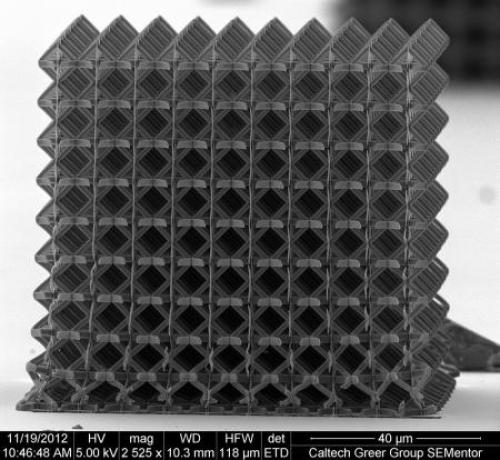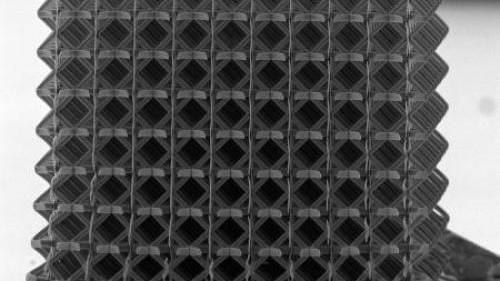Made-To-Order Materials: Engineers Focus On the Nano to Create Strong, Lightweight Materials
Source: sciencedaily.com
The lightweight skeletons of organisms such as sea sponges display a strength that far exceeds that of humanmade products constructed from similar materials.Scientists have long suspected that the difference has to do with the hierarchical architecture of the biological materials -- the way the silica-based skeletons are built up from different structural elements, some of which are measured on the scale of billionths of meters, or nanometers. Now engineers at the California Institute of Technology (Caltech) have mimicked such a structure by creating nanostructured, hollow ceramic scaffolds, and have found that the small building blocks, or unit cells, do indeed display remarkable strength and resistance to failure despite being more than 85 percent air.

Three-dimensional, hollow titanium nitride nanotruss with tessellated octahedral geometry. Each unit cell is on the order of 10 microns, each strut length within the unit cell is about three to five microns, the diameter of each strut is less than one micron, and the thickness of titanium nitride is roughly 75 nanometers.
"Inspired, in part, by hard biological materials and by earlier work by Toby Schaedler and a team from HRL Laboratories, Caltech, and UC Irvine on the fabrication of extremely lightweight microtrusses, we designed architectures with building blocks that are less than five microns long, meaning that they are not resolvable by the human eye," says Julia R. Greer, professor of materials science and mechanics at Caltech. "Constructing these architectures out of materials with nanometer dimensions has enabled us to decouple the materials’ strength from their density and to fabricate so-called structural metamaterials which are very stiff yet extremely lightweight."
At the nanometer scale, solids have been shown to exhibit mechanical properties that differ substantially from those displayed by the same materials at larger scales. For example, Greer’s group has shown previously that at the nanoscale, some metals are about 50 times stronger than usual, and some amorphous materials become ductile rather than brittle. "We are capitalizing on these size effects and using them to make real, three-dimensional structures," Greer says.
[...]
Read the full article at: sciencedaily.com






















